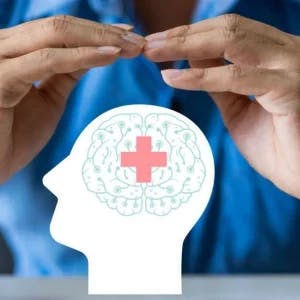When a loved one falls into a coma after stroke, it can be very distressing. While it is impossible to know if or when someone will wake up from a coma, learning about coma after stroke can help families and close friends cope with the uncertainty.
This article explores the current research regarding coma after stroke. Some statistics are also included to hopefully paint a picture of what to expect. Every stroke is different, so the exact progression following coma after stroke can be unpredictable.
However, there are patterns worth noting that may provide an idea of what the future could hold. Family and close friends with a loved one experiencing a coma after stroke may also find comfort by seeking emotional support and connecting with others in a support group.
Please use the links below to jump directly to any section of the article.
- What does it mean to be in a coma?
- Factors associated with coma after stroke
- Prognosis for coma after stroke
- Treatment for coma after stroke
- What happens after loved ones wake up?
What Does It Mean To Be In A Coma?
When an individual enters a coma after a stroke, he or she has entered a state of unconsciousness. They have minimal brain activity, cannot be woken up, and are unable to purposefully react to anything in the environment.
A survivor in a severe coma will not be able to open the eyes or respond to sound, pain or touch. He or she will not have a normal sleep-wake cycle. Furthermore, they cannot initiate any voluntary actions, like squeezing a hand upon command.
A coma rarely lasts longer than 4 weeks. While individuals may seem unaware of their surroundings, there is a chance that survivors in a coma may be aware of what is going on around them, but cannot respond due to the loss of voluntary actions.
Once a survivor regains a sleep-wake cycle, they have progressed to the next stage of consciousness called post-coma unresponsiveness. Typically, this is not diagnosed until individuals have been in this state for at least four weeks. Some move from a coma or post-coma unresponsiveness into a minimally responsive state, where they can inconsistently produce small responses to their surroundings, such as stating a word or two or blinking on command.
The most significant improvements in those experiencing coma after stroke generally occur during the first year of recovery. Although rare, a few survivors have been shown to progress even after being in a coma for multiple years.
A tool many medical professionals use to measure levels of consciousness is the Glasgow Coma Scale. This scale rates a survivor’s responses to stimuli in three areas: eye opening, verbal responses, and motor responses. This can help both doctors and loved ones see small signs of progress, even when it seems little improvement has been made.
Quick summary: When stroke survivors fall into a coma, they are completely unresponsive to their surroundings and lack a sleep-wake cycle.
Factors Associated with Coma After Stroke
To understand why someone has fallen into coma after stroke, it’s important to understand the initial cause of stroke. A stroke occurs when the supply of blood to the brain is compromised. This can result from a clogged artery in the brain (known as ischemic stroke) or uncontrolled bleeding from a ruptured artery in the brain (known as hemorrhagic stroke).
When the blood supply to the brain is affected, whether by ischemic or hemorrhagic stroke, a wide variety of secondary effects and complications may occur, including experiencing a coma. Some factors associated with an increased likelihood of falling into a coma after stroke include:
- Hemorrhagic stroke: One large study of individuals following stroke found that 17% of those with hemorrhagic strokes were admitted to the hospital in a coma, while only 3% of those with ischemic strokes were comatose.
- Massive stroke: Individuals who have experienced a massive stroke are more likely to fall into a coma. This is due to the significant impact stroke can have on the brain. Massive strokes are more likely to involve more complications, such as brain swelling, and require surgical intervention, both of which may increase the risk of coma.
- Brainstem stroke: Strokes that affect the brainstem may also be more likely to result in a coma. This is because part of the brainstem houses the Reticular Activating System (RAS) which controls our arousal states, including waking and sleeping.
- Cerebral edema: When a stroke occurs, it can increase intracranial pressure. Stroke survivors who experience swelling in the brain, known as cerebral edema, often have even greater increases in intracranial pressure, leading to further complications such as coma after stroke.
- Surgery: Sometimes surgery is required to re-establish blood flow in the brain following a stroke. It is possible for a coma to occur after the surgery is done. Additionally, some individuals may be put into a medically-induced coma.
While these factors are associated with an increased risk of coma, every stroke is different, which means that every stroke will lead to different outcomes. However, keeping these factors in mind can help family and close friends understand why a coma may have occurred.
Quick summary: Coma is more common after a hemorrhagic stroke, a massive stroke or a brainstem stroke.
Prognosis for Coma After Stroke
It’s unknown how long a stroke-induced coma will last in any individual since every stroke is different. A coma rarely lasts more than 2-4 weeks. However, in severe cases, a coma can last for years.
While many are fortunate enough to survive coma after stroke, it is one of the most severe effects of stroke. As such, individuals experiencing coma after stroke often have higher mortality rates.
Previously, experts thought that individuals in long-term comas could not recover. However, there have been a few cases of individuals recovering after being in a coma for years that suggest late recovery may be possible, thanks to the remarkable plasticity of the human brain.
If an individual does recover from a coma, they typically regain consciousness slowly, moving through coma recovery stages including post-coma unresponsiveness and a minimally conscious state. The eyes may regain movement first before other voluntary responses slowly appear.
The Ranchos Los Amigos scale can be used as a guide for potentially what to expect as individuals continue to regain awareness. Many become agitated and confused before gradually regaining more functions. However, each individual is different, and may not progress through all stages of recovery.
There is no doubt that waiting for a loved one to wake up from a coma can be distressing. The uncertainty can create anxiety and stress, making it important for loved ones to seek their own support during this time.
Quick summary: Coma rarely lasts for more than 2-4 weeks. Not all individuals survive, but recovery —even late recovery — is possible for some.
Treatment for Coma After Stroke
While it may seem there is nothing individuals can do to help a loved one in a coma, research shows that there are a few options. Some studies show that simply hearing a familiar person’s voice can help speed the recovery process. While they likely will not respond, it is possible that someone in a coma can still hear and may even remember what they’ve been told.
Another treatment option is multisensory stimulation, during which individuals experience input stimulating multiple senses (touch, smell, taste, hearing, vision). While stimulating just one sense may help individuals recover more quickly, different types of sensory input can be even more effective in achieving recovery from coma after stroke.
Studies have also found that when family is involved in sensory stimulation treatments, results are more positive than if only medical professionals are involved. While there is no guarantee that sensory stimulation will make a person more alert, it is a simple, low cost method that numerous studies have supported.
One new treatment option with limited evidence is ultrasound therapy. This is also non-invasive, and is thought to work by sending low-intensity ultrasound waves into the brain to excite nervous tissue in areas such as the thalamus. One individual who was in a minimally conscious state for 14 months following stroke improved his level of awareness following only two sessions of ultrasound therapy.
Researchers are consistently looking for new ways to improve recovery outcomes for coma after stroke. Although many experience poor outcomes, loved ones can help to improve the recovery outlook by being involved in their family member’s care.
Quick summary: The treatment option with the most evidence is sensory stimulation. This can be as simple as just talking to or touching a loved one who is in a coma after stroke.
What Happens When Loved Ones Wake Up?
If your loved one wakes up from a stroke-induced coma, it’s time to prepare for the road to recovery ahead. Because a coma is more common after a massive stroke, it’s likely that the individual has sustained significant changes to cognition and mobility, such as memory loss and post-stroke paralysis. This means it’s important to start rehabilitation as soon as possible.
By participating in rigorous therapy, stroke survivors can make remarkable recoveries, thanks to the brain’s remarkable plasticity and ability to heal itself. While individuals are healing, the support of family members is vital. Many family members become caregivers and/or active participants in the survivor’s rehabilitation.
Family and close friends may also find it helpful to join a stroke support group to talk with others in similar situations. This is a great way to gain knowledge, insight, and support.
Quick summary: After waking up from a coma, stroke survivors often need the support of family as they participate in rigorous rehabilitation to continue to improve.
Understanding Coma After Stroke
Coma after stroke is a very serious condition in which individuals lose consciousness for a period of time. While most comas do not last longer than four weeks, awakening from a coma is just one step on a long road to recovery.
Individuals who’ve experienced massive strokes, hemorrhagic strokes, or brainstem strokes are more likely to fall into a coma. However, family members and medical staff can help promote recovery from coma by providing sensory stimulation through activities such as talking with the patient.
Hopefully this article provided valuable insight into why coma after stroke may occur, and how to boost the possibility of recovery.















